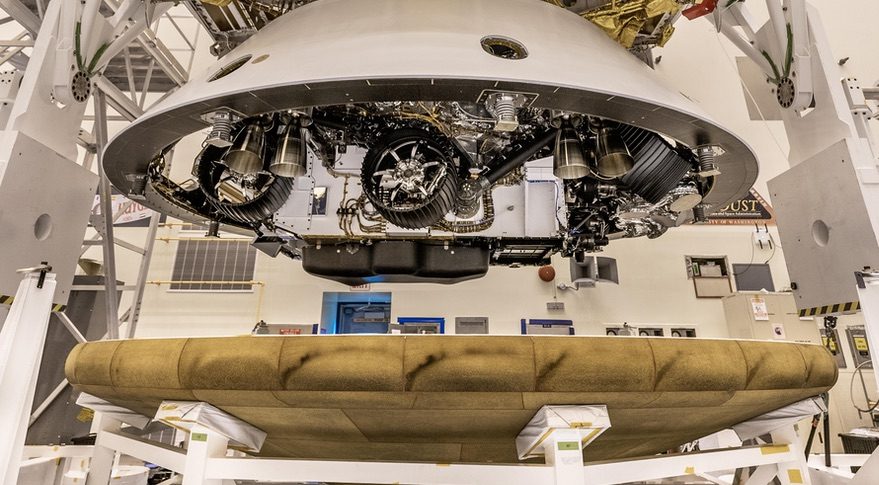NASA confident Mars 2020 will launch on schedule
NASA confident Mars 2020 will launch on schedule

WASHINGTON — NASA officials say they’re confident that the Mars 2020 Perseverance rover mission will launch this summer amid the special measures the agency had to take to keep the mission on track during the coronavirus pandemic.
The mission is currently scheduled for launch July 20 on a United Launch Alliance Atlas 5 from Cape Canaveral Air Force Station in Florida. The launch was originally scheduled for July 17 but slipped three days when a problem with a crane delayed ground processing of the rocket.
Processing of the spacecraft itself, though, is on schedule, project officials said during a June 17 online briefing about the mission. The spacecraft will soon be encapsulated inside the rocket’s payload fairing, and then transported to the Atlas 5 Vertical Integration Facility to be installed on top of the rocket.
Any problems that take place over the next month would likely further delay the launch. “We are a ‘green light’ schedule from here on out. In other words, any major perturbations could affect the launch date,” said Omar Baez, launch director for the mission in NASA’s Launch Services Program.
However, both he and Matt Wallace, deputy project manager for Mars 2020, said the length of the overall launch period, which extends to Aug. 11, should be more than sufficient to accommodate any last-minute issues. “We think we have some robustness there, some good robustness there, in the launch window,” Wallace said.
Baez said that while the launch period extends to Aug. 11, there was a possibility the window could be extended to as late as Aug. 15. “There’s no concerns from our part” about the schedule, he said.
If Mars 2020 did miss its launch window, it would have to wait until the next Mars launch window opens in 26 months. That’s a key reason why NASA made preparations for the mission’s launch one of its highest priorities during the pandemic, alongside the Demo-2 commercial crew launch May 30.
“It’s very expensive if we have to take Perseverance and put it back into storage for a period of two years,” said NASA Administrator Jim Bridenstine. “It could cost half a billion dollars.”
Bridenstine has also stated in past events that a two-year slip in the launch of Mars 2020 could cost about $500 million, but the agency has not released itemized costs, such as storage of the spacecraft and salaries for personnel working on the mission. Spokespersons at the Jet Propulsion Laboratory, which manages the Mars 2020 mission, referred questions about that cost estimate to NASA Headquarters, which did not immediately respond.
To keep the mission on schedule, NASA instituted an effort called “Mars 2020 Safe at Work” to ensure that those working on the mission could do so safely. “The objective was to keep the team as safe, or safer, than they would be if they were not working,” said Wallace. “Putting a spacecraft together that’s going to Mars and not making a mistake is hard no matter what. Trying to do it during the middle of a pandemic is a lot harder.”
NASA is taking a different approach to public participation in the launch than it did with the Demo-2 mission. For Demo-2, Bridenstine urged the public to watch the launch at home to avoid large crowds that could cause new COVID-19 outbreaks. That’s not the case for the upcoming Mars 2020 launch.
“We’re not telling people not to visit for this launch,” he said. While the Kennedy Space Center itself will not be open for the launch, which he said was a move to protect the workforce as it prepares for the return of the Crew Dragon spacecraft later this summer and other missions, he instead urged the public to follow state guidelines for social distancing, wearing masks and other preventative measures.
He added that his earlier advice for the Demo-2 mission went unheeded anyway, with large crowds gathering outside KSC grounds. “We asked people not to travel,” he said. “It appears they didn’t listen to us.”
There has been surge in COVID-19 cases in Florida even as the state has relaxed restrictions imposed earlier this year to halt its spread. Brevard County, which includes KSC, reported the highest number of new cases in at least a month June 16, with June 15 a close second, according to Florida’s official COVID-19 Data and Surveillance Dashboard.
To memorialize the pandemic, the mission added a small plate to the rover, measuring 8 by 13 centimeters. The plate features a version of the medical symbol known as the Rod of Asclepius, with a serpent entwined around a rod. On top of the rod is an image of the Earth that shows the launch trajectory of the Mars 2020 mission.
The inclusion of the Rod of Asclepius, Wallace said, was to honor the medical profession for their efforts battling the pandemic. “They really inspired us, I think, through this period, and we hope that this plate, and we hope that this mission, in a small way can inspire them in return,” he said.
The name of the rover itself, announced early in the year through a student competition, has now become a symbol for the mission. “When ‘Perseverance’ was first selected, I wasn’t sure about it, to be honest,” said Katie Stack Morgan, deputy project scientist. “I’m a convert now. Perseverance is the right name for the rover. I think it’s now a really important symbol of humanity hopefully persevering though this great challenging time.”
Comments
Post a Comment